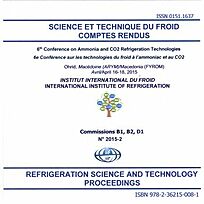
Document IIF
CO2 evaporative condensers and gas coolers enable efficient CO2 refrigeration application worldwide.
Numéro : pap. n. 2
Auteurs : VISSER K.
Résumé
It is a known fact that in the case of ammonia condensing it is possible to operate an evaporative condenser at an air entry wet bulb temperature to condensing temperature approach of 6 K. This means that a properly designed evaporative condenser for subcritical CO2 condensing at 30°C maximum, i.e. 1.1 K below the critical point, may be applied for a wet bulb design condition of 24°C or lower. It is also known that the energy efficiency of transcritical CO2 refrigeration improves quickly with a reducing gas cooler exit temperature. It was soon realised that it would not be very difficult to reduce the CO2 gas cooler exit temperature to a three K approach to the Ambient Wet Bulb Temperature (AWBT) in an evaporatively cooled gas cooler. Thus it is possible to achieve a gas cooler exit temperature of 31°C at an AWBT of 28°C, a value which is not exceeded in about 98% of the world’s climates. The benefits of applying evaporative condensing techniques for the condensation of subcritical CO2 are examined. They are lower design pressures, lower energy consumption, lower running and operating costs when compared to all commonly used refrigerants currently used, both natural and chemical refrigerants. Hot gas defrosting may also become a standard feature of subcritical CO2 refrigeration plant operations. It is shown that water consumption of an evaporative condenser may be reduced significantly by fitting an air cooled dry cooling coil in the exhaust air stream of an evaporative condenser. This coil removes a large part of the unusually high proportion of sensible heat from condensing at 30°C. Similar water saving may also be achieved when cooling transcritical CO2 fluid in an evaporatively cooled gas cooler. It is concluded that the use of evaporative condensers and gas coolers for CO2 in temperate and subtropical, and tropical climates respectively would make CO2 refrigeration as ubiquitous as any chemical refrigerant and would compete successfully with all currently used refrigerants, natural or chemical. Indeed, where parallel compression is an integral part of a sub or transcritical CO2 refrigerating system, the CO2 system will outperform all currently used refrigerants, including ammonia. Furthermore, the use of devices for expansion energy recovery such as expanders and ejectors is no longer required. Finally, suction heat exchangers are no longer required to reduce the gas cooler exit temperature.
Documents disponibles
Format PDF
Pages : 8 p.
Disponible
Prix public
20 €
Prix membre*
15 €
* meilleur tarif applicable selon le type d'adhésion (voir le détail des avantages des adhésions individuelles et collectives)
Détails
- Titre original : CO2 evaporative condensers and gas coolers enable efficient CO2 refrigeration application worldwide.
- Identifiant de la fiche : 30014577
- Langues : Anglais
- Source : 6th Conference on Ammonia and CO2 Refrigeration Technology. Proceedings: Ohrid, North Macedonia, April 16-18, 2015.
- Date d'édition : 16/04/2015
Liens
Voir d'autres communications du même compte rendu (53)
Voir le compte rendu de la conférence
Indexation
-
Experimental analysis of an IHX in a CO2 subcri...
- Auteurs : LLOPIS R., SÁNCHEZ D., CABELLO R., et al.
- Date : 03/05/2016
- Langues : Anglais
- Source : CYTEF 2016. VIII Congreso Ibérico y VI Congreso Iberoamericano de las Ciencias y Técnicas del Frío, Coimbra-Portugal, 3-6 mayo, 2016.
- Formats : PDF
Voir la fiche
-
Effect of geometry on the performance of CO2 ga...
- Auteurs : GE Y., TASSOU S., TSAMOS K., et al.
- Date : 16/08/2015
- Langues : Anglais
- Source : Proceedings of the 24th IIR International Congress of Refrigeration: Yokohama, Japan, August 16-22, 2015.
- Formats : PDF
Voir la fiche
-
Design and integration of CO2 gas cooler/conden...
- Auteurs : GE Y. T., TASSOU S. A., DEWA SANTOSA I., et al.
- Date : 23/06/2014
- Langues : Anglais
- Source : 3rd IIR International Conference on Sustainability and the Cold Chain. Proceedings: London, UK, June 23-25, 2014
- Formats : PDF
Voir la fiche
-
New generation of air cooled heat exchangers fo...
- Auteurs : FILIPPINI S., MERLO U.
- Date : 16/04/2015
- Langues : Anglais
- Source : 6th Conference on Ammonia and CO2 Refrigeration Technology. Proceedings: Ohrid, North Macedonia, April 16-18, 2015.
- Formats : PDF
Voir la fiche
-
Performance relationship of air-cooled CO2...
- Auteurs : DOORNBOS G., HEININGEN K. van, GERRITSEN J.
- Date : 13/06/2022
- Langues : Anglais
- Source : 15th IIR-Gustav Lorentzen Conference on Natural Refrigerants (GL2022). Proceedings. Trondheim, Norway, June 13-15th 2022.
- Formats : PDF
Voir la fiche
